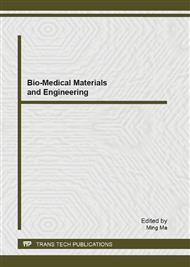p.60
p.65
p.71
p.77
p.82
p.87
p.93
p.99
p.106
Luminescent Hybrids of Eu3+ Complexes Covalently Bonded with Mesoporous Silica and PMAA
Abstract:
Binary organic-inorganic mesoporous hybrid materials were prepared by covalntly grafting Lanthanide (III) (Eu) trifluoroacetylaceton (TAA) complexes to the ordered meosoporous silica SBA-15 via hydrothermal method and hydrolysis and co-polycondensation method with the surfactant P123 and TEOS. Besides, Novel ternary lanthanide (III) (Eu) organic-inorganic-polymeric mesoporous hybrid materials have been synthesized as well through the introduction of the organic polymer PMAA to the binary system with covalent bond. We investigated the thermal stability and luminescence properties of hybrids and found that the ternary hybrid materials exhibit better thermal stability and stronger emission intensity. Furthermore, compared with the binary mesoporous material Eu (TAA-SBA-15)3, the ternary mesoporous material Eu (TAA-SBA-15)3PMMA exhibits the characteristic emission of the Eu3+ ion with a higher luminescence Intensity, suggesting that the introduction of polymer PMMA into the mesoporous matrix is of benefit for the sensitization of Eu3+ luminescence, by replacing H2O groups that can quench the luminescence of Eu3+ ion.
Info:
Periodical:
Pages:
82-86
Citation:
Online since:
August 2013
Authors:
Keywords:
Price:
Сopyright:
© 2013 Trans Tech Publications Ltd. All Rights Reserved
Share:
Citation:


